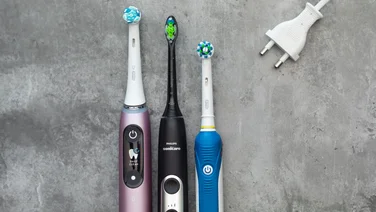To help us provide you with free impartial advice, we may earn a commission if you buy through links on our site. Learn more

Anyone who has a filling will soon discover that they don’t last forever – and losing a filling is actually quite common. Whether the result of everyday wear and tear, grinding your teeth, clenching teeth or a build-up of plaque – there are a whole host of reasons that could cause a filling to fall out.
First things first: don’t panic. It’s inevitable that fillings will need to be replaced from time to time and, while inconvenient (and sometimes uncomfortable), a lost filling shouldn’t be a major problem.
Below, you’ll find our guide the action you should take if you find that your filling has become loose or fallen out.
It’s worth noting, however, that looking after your oral health with careful brushing can extend the lifespan of a filling, so also read our guide on ‘How to use an electric toothbrush’ to help avoid unplanned – and expensive – visits to the dentist’s chair.
What is a filling?
Fillings are used by dentists to fill a cavity (hole) in your teeth, or to repair minor fractures and chips to restore the tooth back to its normal shape. They can be made from a range of materials, with your dentist choosing the most appropriate for the type of filling you need:
- Dental amalgam fillings are a mix of silver-coloured metal, usually made up of mercury, silver tin and copper. They’re often used to fill holes in the back teeth since they’re the most durable.
- Composite fillings are the same colour as your teeth, so are often used on more visible teeth, including the front teeth. They’re made of resin and glass.
- Glass ionomer fillings are also tooth coloured but made from powdered glass. They bond with the tooth and can release fluoride to provide ongoing protection against decay.
READ NEXT: Best electric toothbrushes
What are the signs that your filling has fallen out?
If you lose a filling while eating then you may experience that tell-tale unexpected crunch; you may even swallow the filling. The hole in the affected tooth will now likely be exposed and you’ll be able to feel the open cavity with your tongue.
What should you do if your filling falls out?
Nyree Whitley, chief clinical officer at mydentist says: “If your filling falls out or becomes dislodged, call your dentist and try to get a check up as soon as you can.”
While you may be uncomfortable, it’s unlikely that it presents a dental emergency – unless you are in serious pain, or there is bleeding that won’t stop – so you may have to wait for an appointment. Do not wait too long to see a dentist, however, as you run the risk of further problems, including tooth decay.
What should you do until you can see a dentist?
Keep it clean, advises Nyree: “Until you can see your dentist, it’s advisable that you keep the tooth as clean as possible. Rinsing with an antibacterial mouthwash and maintaining a good overall oral healthcare routine – such as regularly brushing your teeth and flossing – will help you do this.”
Note that since the cavity will now be exposed, it’s vulnerable to becoming infected, so using a decent antibacterial mouthwash is important. Your tooth may also be newly sensitive, so try a product such as Listerine Total Care Sensitive, which our tester found left mouths “clean, without causing pain or discomfort”.
When flossing, try to use a water flosser rather than tape or dental string, which could be too abrasive. In tests, we found Panasonic’s EW1511 water flosser “does the best job of leaving your teeth and gums feeling spotless”. If you’re new to water flossing, read our guide on ‘How to use a water flosser’.
While you can continue to eat and drink, try to limit chewing using the affected tooth and ensure you rinse your mouth afterwards.
READ NEXT: Best Oral-B electric toothbrushes
What to expect at the dentist
At your appointment, your dentist will examine the area before cleaning away any infection. If the filling has been chipped, fractured or broken, then it may be repairable or will be replaced. More serious cases involving deep cavities, exposed nerves or fractures to the tooth may require further treatment, such as extraction or root canal work.






